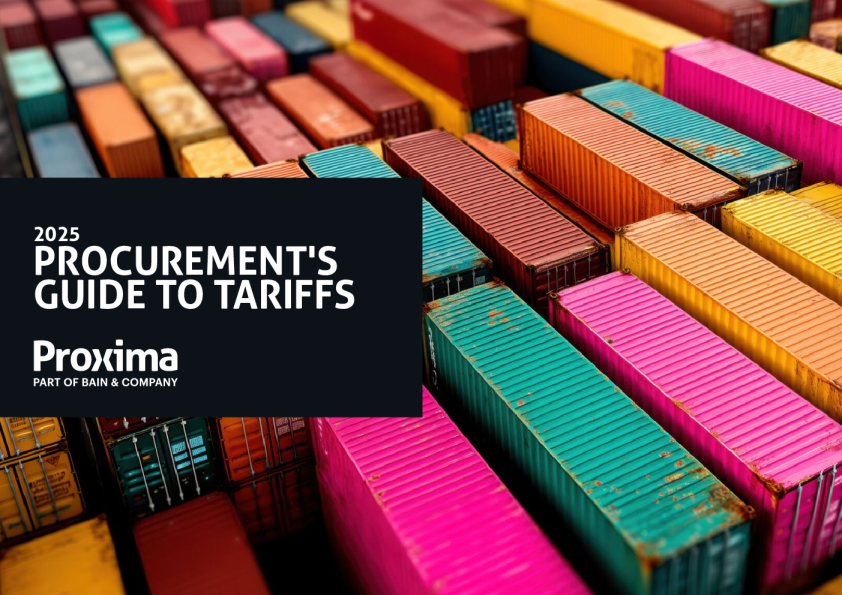2025年采购关税指南
 AI智能总结
AI智能总结
CONTENTS EXECUTIVE SUMMARY TARIFFS 101:UNDERSTANDING THE BASICS ROLE OF PROCUREMENT:PRACTICAL STEPS FOR NOWAND THE FUTURE WHAT ELSE DO YOU NEED TOKNOW?FAQS & FURTHER INFORMATION THE ROAD AHEAD:WHAT TO DO NEXT So, is the latest shake-up to trade policy just another accelerator towards tradeliberalization? The name given to April 2ndwould suggest such. At the time of writing this, we are yet to fully understand how tariffs—imposedand proposed—will fully play out. However, the US administration's objectives areclear: restore domestic industry in the US, establish balanced trade, andstrengthen national security. Perhaps it is not the objectives that many disagree with; rather,it is the speed ofimplementing those objectivesthat has caught businesses and nations out andput most firmly on the back foot, searching for bargaining chips. This speed is forcing businesses to consider and fast-track decisions thatordinarily would not be on the agenda for 2025 and would conventionally take farmore than 90 days to work through.It is forcing short-term actions, adaptability,and mid-term planningfor a new business model. Winners will be those whosuccessfully achieve both. Tariffs are not new;globalization has been slowing, and the objectives of theTrump administration have been forewarned. But beyond the headlines, andgetting back to basics, what are tariffs? How do they work? And how canbusinesses face them? WHAT HAPPENS NEXT? IN THE UNCERTAINTY, ONE THING IS CLEAR A 90-day pause, or a 90-day scramble, as nationsdecide how to respond and businesses act now andplan for next? The conventional rules of a globaleconomy, such as the economic advantages ofaccess to lower-cost labor and the availability of keyresources, are likely to alter. But to what extent? Procurement is at the helm of some significant business decisions, both in theshort term as organizations battle through the day-to-day decisions and deal withwhat’s in front of them—e.g., stockpiling, delaying shipments, pausingexpansion—and in the longer term as they plan for a solution that suits the ‘newworld’ that will emerge once the tariff dust starts to settle. There are multiple ways that this can play out.Larger economies (and trading blocs) may choosetofight fire with fire, depending on their ownimport/export dynamics. Yet smaller emergingeconomies, such as those surrounding China,mayget caught in the crossfire. These decisions will be led by resilience and agility and informed byunderstanding the exposure within supply chains. This guide explores procurement's integral role in the tariff landscape and sharespractical stepsto equip procurement professionals for the uncertainty of thecoming months and potentially (most likely) beyond. Businesses cross borders in a way that nations donot. Underneath the country-level view is a far-reaching,complex network of organizations andsupply chainsthat need to quickly adapt to thenew model, whatever that may be. Newpartnerships may be forged, and new investmentsmay be made, in North America and elsewhere. For some, it will be business near usual; for others,it will meanchanges in the balanceof who andwhere they buy from and who they sell to. TARIFFS 101:UNDERSTANDING THE BASICS THE BASICS There has, somewhat predictably, been a large spike in interest in the phrase ‘what is a tariff?’,particularly in the US, where there has been a YOY increase of 400% in Google searches. Here’s a quick explainer. There are different models,the main focus for manyorganizations currently is'Ad Valorem' Tariffs. The importer pays the fulltariff, and decides whetherto pass the tariff cost on inthe supply chain or absorbsome of that cost. Theimporter pays,whichmay be a step in thesupply chain(manufacturer/distributor)or the end customer. Tariffs are paid at thetime of customsclearance to thegovernment whengoods enter theimporting country. A trade tariff is a chargeapplied when goods crossan international border,where the ownership ofthe goods transfers to thenext party. AD VALOREM TARIFFS: Ultimately, the endcustomer pays the totalcosts not absorbed byother parties. charged as a % of thedeclared value of the goods. Payment is due beforethe goods are releasedfor sale or furtherdistribution. SPECIFIC TARIFFS:chargedas a fixed amount per unit,regardless of value. See Incotermsfor more detail COMPOUND TARIFFS:amix of both. TARIFFS ARE NOT NEW, THEY AREONE OF THE OLDEST TOOLS INTRADE HISTORY Many reasons exist as to why a country ortrading bloc (like NAFTA or the EU) might havetariffs or trade agreements in place. BALANCING COST AGAINST VARIED TRADINGSTANDARDS OR SUBSIDIES:For example, the EUtariffs on US imports on automobiles, chicken,beef, and other foodstuffs, in theory, toreflectvery different standards applied to theEuropean market.This may incur additionalproduction costs, with out which would leaveEuropean producers at a disadvantage. LEVELING THE PLAYING FIELD FOR VARIED BILATERAL TRADE AGREEMENTS TO REG




